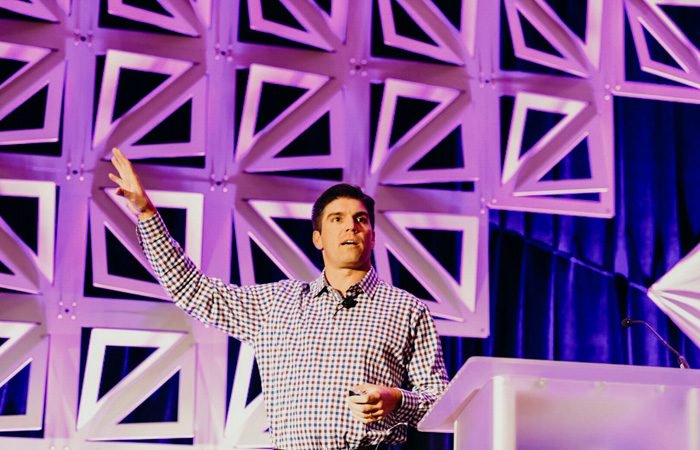HR leaders share how virtual reality is reshaping training at their companies.

Derek Belch, CEO and founder of virtual reality firm STRIVR, speaks during a panel at the HR Technology Conference.
Virtual reality isn’t just for entertainment—at a growing number of companies, it’s being put to use to train employees in the fine art of working safely and providing superior customer service and to assess them for new roles. Two of those companies—Walmart and FedEx Ground—were on hand at the HR Tech Conference on Thursday to share their stories.
SUBSCRIBE here to receive our daily emails.
Walmart began using VR for training several years ago, said Heather Durtschi, senior director of content design and development. The global retailer got in touch with VR firm STRIVR after learning about its work training the University of Arkansas’ Razorbacks football team. Derek Belch, the company’s founder and CEO, was a kicker on Stanford University’s football team and later wrote his master’s thesis on the use of VR for football training.
Watch our HR Tech 2019 videos here.
“VR is intended to provide complete mental transportation,” said Belch, who also spoke at the session. “Your body is one place, but your brain thinks you’re somewhere else.”
Although VR has been around for four decades (starting out being used primarily by the military and for pilot training), it is now—thanks to advances in technology such as Oculus Rift—in the “cheaper, lighter, faster” era, said Belch.
VR allows for body movement in two “degrees,” he said: Three degrees and six degrees. Six allows for complete body movement, with the VR scenario adjusting itself to the user’s body position. Three offers much more limited movement, primarily with the head. However, six is very difficult to scale for most companies, said Belch.
HRE at HR TECH: Follow along for full conference coverage here.
VR for training is often referred to as “immersive training,” he said. It combines virtual reality with advanced learning theory, data science and spatial design.
At Walmart, VR training is being used to assess employees and new hires for various roles within its stores, said Durtschi.
“We use VR to assessing their listening and problem-solving skills to see if, for example, they’re a good fit for a team leader role,” she said. “It’s just one data point, but what we’re seeing is that VR can make the same—if not better—predictions for who will succeed in a role than a human.”
The VR training has come in handily in unexpected ways. In the wake of the tragic active shooter event at a Walmart in El Paso, Texas earlier this year, Walmart employees said their VR training helped them respond more quickly and effectively, said Durtschi.
At FedEx Ground, the freight company is using VR to train new hires for warehouse jobs—jobs that can be strenuous and dangerous, said Denise Abbott, the company’s vice president of HR.
“We have over 100,000 employees—we had a lot of immediate turnover among folks we hired, so we figured this training could give them a much more realistic sense of what warehouse work entails,” she said.
HR Tech 2019: How to get started on analytics
VR is helping FedEx Ground improve its training from an employee experience standpoint, said Jefferson Welch, director of HR for FedEx Ground University. “It’s almost impossible to demonstrate in a classroom environment the various moving components of this type of job—working on loading docks, lifting—so this lets us bring immersive learning technology into the classroom, so they can practice before they ever set foot ‘on the dock,’ as we say.”
Employees at Walmart have been enthusiastic about the training, said Durtschi.
“We’ve heard nothing but great things from associates who use this,” she said. “Assessment scores went up among those who went through VR training vs. those who didn’t. They feel like they’re actually in the training, and you can’t replicate that through role playing.”


Recent Comments